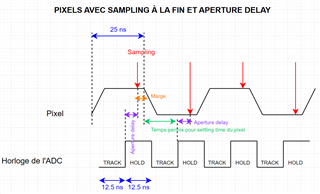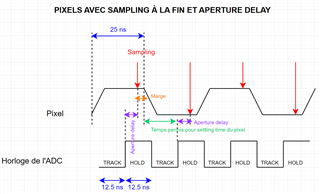Tool/software:
Hi,
I plan to use the ADS5294 to perform the acquisition of a high speed analog image sensor, and I need some help understanding the implication of the aperture delay specification.
My sensor is outputing a new pixel analog value every 25 ns and I need to make one acqusition per pixel. I will therefore use a 40 MHz sampling frequency.
The rising time of the analog pixel is typically 23ns. If I set the ADC clock phase so that its rising edge (beginning of the hold phase) is at 23 ns, the sampling switch will actually be fully open 4 ns later (aperture delay specification), which give me 23 + 4 = 27 ns. As you can see, this is too long, as the analog image sensor is already outputing its next pixel at 25 ns.
So in order to avoid that, my idea is to change the ADC clock phase so that is rising edge is at 19ns, which means the sampling switch will be fully open at 23 ns. Can I do this and simply compensate the aperture delay by anticipating it, or is there another concern I should be aware of?
If I anticipate it like I described above, the analog pixel will continue to rise while the sampling switch is opening ; can this cause an error? Which value will be sampled by the ADC?
In a few words, does my analog signal need to be stabilized before the aperture delay phase begins?
Best regards,
Maxime Puech



